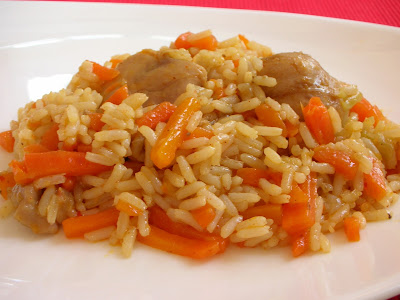 |
| Kyrgyz chicken plov |
Pilaf, plov, pulao, pilahvi, pelau, paella...different names for a rice based dish common in many countries. The Kyrgyz version called plov has meat and carrots while dried fruits and nuts are added in some other Central Asian countries like Tajikistan. Carrots are not commonly used to make plov other than in Central Asia. The Pakistani pulau has meat and lot of spices, the Spanish paella includes seafood while the Italian pilota has meat incorporated into a rice risotto.
Plov is a surprisingly tasty dish made with just a few core ingredients. The Central Asian plov is probably almost always cooked with unlean (fatty!) chunks of meat and bones. Generally red meat is used but chicken plov is quite nice as well. Today I used (boneless!) sausage. Using sausage is uncommon, I used it because that’s what I had in the freezer.
Few points to note when making plov:
1. If you plan to use boneless meat keep the bones and add it together with meat when cooking
2. Garlic is cooked in stock, not sautéed. If you really want to sauté the garlic make sure it does not turn brown or burn, you will taste this later. I already made this mistake!
3. If you want to add spices, use pepper and cumin. Mixed herbs also works well.
4. Don’t be shy with the carrots. This is a carrot and meat dish after all, they both play a lead role.
3. If you want to add spices, use pepper and cumin. Mixed herbs also works well.
4. Don’t be shy with the carrots. This is a carrot and meat dish after all, they both play a lead role.
I got asked a question regarding type of rice to use. I use parboiled rice. I think wholegrain/brown rice will work well also. For authentic Kyrgyz plov the variety of rice used is probably difficult to find in Europe. The rice is colored brick red, when you wash it the water turns red and streaks of red remain on the rice, even after cooking. The rice is thicker than long grain. Its thickness is comparable to calrose/arborio but longer and not as starchy. The rice remains firm even after cooking.
The recipe below is for one generous portion. A ‘standard’ recipe uses 1 part meat, 1 part carrots and two parts rice, by weight.
~~~~~~~~~~~~~~~~~~~~~~~~~~~~~~~~~~~~~~~~~~~~~~~~~~~
Ingredients
One portion meat (100-150 grams) cut into 2cm cubes, or bigger
1 large carrot, cut into strips (about 2 cm long and 2-3mm wide)
½ medium sized onion, diced
1 large clove garlic, diced
50ml rice, thoroughly washed
75 ml water
2 tablespoons oil
Directions
1. Heat oil over medium flame
2. Add meat, carrots, onion and salt. Cook until the meat has browned, about 20 minutes. Stir occasionally to prevent sticking
3. Add water and garlic, cover and gently simmer for 10-15 minutes
4. Reduce heat to medium low, add rice and cook covered until rice is done, about 25-30 minutes
5. Serve. If you want to be authentic serve a large 'mountain' of plov scattered with chunks of meaty bones and a whole bulb of steamed garlic sitting on top


I think I already responded to this and my comment has been lost in the ether :-). At any rate, I just wanted you to know that this looks and sounds delicious. I hope you have a great day. Blessings...MAry
ReplyDeleteWhat kind of rice do you use for this? I tried making plov last year but the rice I used (basmati) wasn't correct...
ReplyDeleteHi Su-Lin, I use parboil rice. I think wholegrain/brown rice will work well also. For authentic Kyrgyz plov the variety of rice used is probably difficult to find in Europe. The rice is colored brick red, when you wash it the water turns red and streaks of red remain on the rice, even after cooking. The rice is thicker than long grain. Its thickness is comparable to calrose/arborio but longer and not as starchy. The rice remains firm even after cooking. Hope this is not too confusing!
ReplyDeletethis rice and carrot looks so good, simple yet delicious!
ReplyDeleteI can just taste all that sweetness from the carrots! Pulao, plov, pilaf ... whatever... I call it YUM!
ReplyDeleteThat plov looks delicious! I love such scrumptious rice dishes.
ReplyDeleteCheers,
Rosa
Flag of Kyrgyzstan
ReplyDeleteYou mention salt in the instructions, but it's not in the ingredients. How much do you recommend?
ReplyDelete